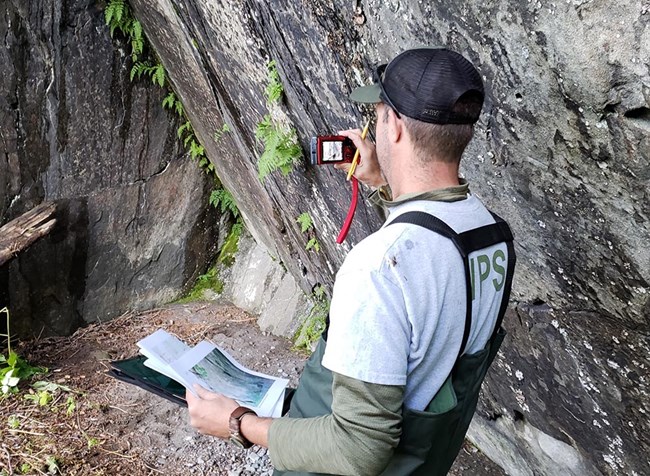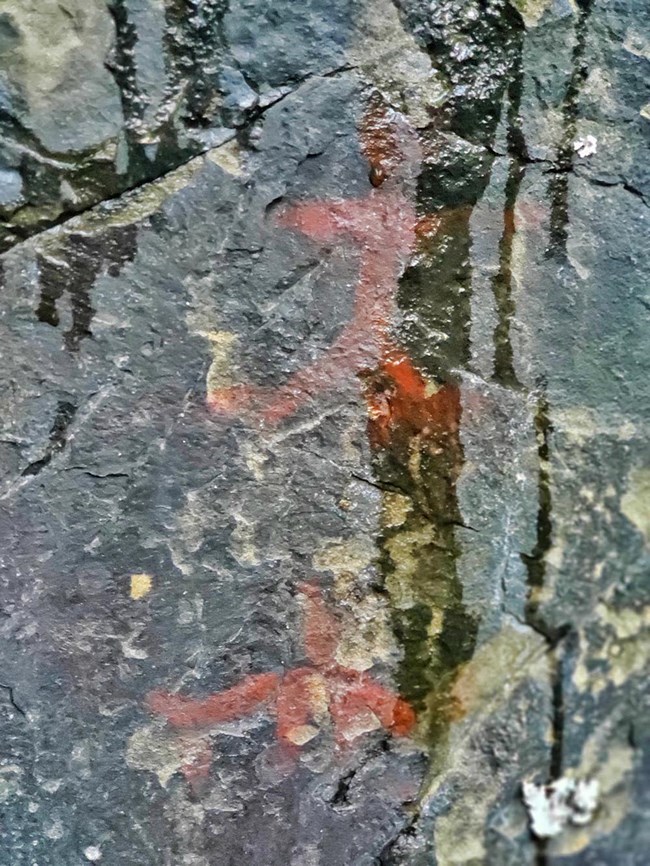Last updated: August 10, 2023
Article
Clam Cove Pictographs

Clam Cove archeological site in Lake Clark National Park and Preserve is one of just three pictograph sites documented in Alaska parks. It is located in a bay the Dena'ina called Niłghenk’enulyun, translated as "mixed vegetation grown together." Organic material samples—shells and wood charcoal—from near the site were sent for radiocarbon dating analysis, from which we concluded that the pictographs could be as old as 1,700 years before present, in the Kachemak Tradition.
The pictograph brick-red paint was also analyzed. We expected to find the pigment to be made from red ocher (iron oxide, Fe2O3), but there was very little iron content found in the analysis, nor was there vermillion (mercury sulfide, HgS) or realgar (arsenic sulfide, As2S2). While the tests were inconclusive, it appears likely that the reddish pigment was produced from a specific claystone found locally at the bay.

The images depict umiak boats, weapons (harpoons), sea mammals (whales), and people engaged in ocean-going activities. These images are similar to other pictographs found in Kachemak Bay and Prince William Sound in Southcentral Alaska. They also share commonalities with the Pegtymel petroglyphs in Chukotka, northeastern Siberia. The cultural affiliations remain unclear, with likely attribution to the Alutiit and the Dena'ina. The subject of the images is consistent with Alutiiq religious and spiritual traditions and could indicate their occupation of the site prior to Dena'ina occupation. This is consistent with current understanding of Dena'ina occupation along Cook Inlet beginning around 2,000 years ago.
This location is archeologically and ethnographically known as a cultural crossroads for the last 3,000 years. At the time of European contact, it was in the southern corner of the Dena'ina territory and close to where Yup'ik, Alutiiq, and Dena'ina territories intersected. It may be that the pictographs were a kind of territorial marker.
The site is unfortunately being impacted by climate change. Increased moisture and water run-off are gradually degrading the pictographs, compounded by the lichen growth and exfoliation of the rock surface.
This work builds on the documentation and analysis of many researchers from the site's excavation in 1969 to work continued in the early 2000s and recent analyses. The National Park Service will continue monitoring the site and provide additional research regarding site history, cultural significance, and regional connections. We will work with descendant communities and knowledge keepers as an essential component of this research. We are committed to a dialogical and ethical approach that integrates expertise and knowledge and active partnerships that contribute to sound management decisions and practices.
The Archaeology of Clam Cove, Lake Clark National Park and Preserve, Southcentral Alaska
Abstract
This article reviews the history of site investigations at the Clam Cove site (SEL-006) in Southcentral Alaska. Radiocarbon dates from the subsurface archaeological deposits at the site suggest that this portion of the rockshelter excavated by Joan Townsend in 1969 dates to 1700 radiocarbon years ago. Studies of archaeobotanical and shellfish remains provide context for the activities of the site residents during this time. Although we do not know the antiquity of the pictographs on the walls of the rockshelter, contextual evidence suggests these are affiliated with the Alutiiq or their ancestors. This article reviews the history of site investigations over the last 53 years and shows how recent analyses contribute to knowledge of Cook Inlet precontact history. We reflect on the importance of site monitoring and working with descendant communities to ensure ethical engagements and interpretations of the site.
Baird, M., M. Moss, S. Perrot-Minnot, and J. Rogers. 2022. The archaeology of Clam Cove, Lake Clark National Park and Preserve, Southcentral Alaska. Alaska Journal of Anthropology 20(1-2): 85-102.
